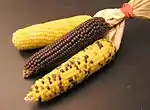Purple corn
Purple corn (Spanish: maíz morado) or purple maize is a variety of flint maize (Zea mays indurata) originating from South America. It is more commonly seen in Peru, Bolivia, Colombia and Ecuador.

Uses
The kernels of purple corn are soaked in hot water by people of the Andes to yield a deep purple color for foods and beverages, a practice now recognized for its industrial uses as a colorant. Common in Peru, purple corn is used in chicha morada, a drink made by boiling ground purple corn kernels with pineapple, cinnamon, clove, and sugar, and in mazamorra, a type of pudding. One of the most popular purple corn food uses is the "Api", a smoothie served hot and sometimes called "Inca's dessert".[1]
Color chemistry: anthocyanins
The pigment giving purple corn its vivid color derives from an exceptional content of a class of polyphenols called anthocyanins. Cyanidin 3-O-glucoside, also called chrysanthemin, is the major anthocyanin in purple corn kernels, comprising about 73% of all anthocyanins present.[2][3][4] Other anthocyanins identified are pelargonidin 3-O-β-D-glucoside, peonidin 3-O-β-D-glucoside, cyanidin 3-O-β-D-(6-malonyl-glucoside), pelargonidin 3-O-β-D-(6-malonyl-glucoside) and peonidin 3-O-β-D-(6-malonyl-glucoside).[2][3][4] Similar results for anthocyanin content were found from a variety of purple corn grown in China.[5]
Evaluating growing conditions for anthocyanin and total polyphenol content, one research group found that field location was an important determinant, whereas seedling density and soil potassium content were not.[6]
For ease of extractions, scientists have explored components of the purple corn plant for yield, such as kernels, cob and husk, possibly allowing use of a plentiful, non-edible residual biomass in cobs or husks. Husks of the purple corn plant contain about ten times higher content of anthocyanins than do kernels.[4]
References
- "De Arequipa a Mistura: Api, una mazamorra bebible hecha con maíz morado". El Comercio Peru. Retrieved 21 Feb 2013.
- Aoki H, Kuze N, Kato Y (n.d.). "Anthocyanins isolated from purple corn (Zea mays L.)" (PDF). unidentified manuscript. Archived from the original (PDF) on 29 October 2013. Retrieved 19 June 2014.CS1 maint: uses authors parameter (link)
- Cuevas Montilla, E; Hillebrand, S; Antezana, A; Winterhalter, P (2011). "Soluble and bound phenolic compounds in different Bolivian purple corn ( Zea mays L.) cultivars". Journal of Agricultural and Food Chemistry. 59 (13): 7068–74. doi:10.1021/jf201061x. PMID 21639140.
- Li, C. Y.; Kim, H. W.; Won, S. R.; et al. (2008). "Corn husk as a potential source of anthocyanins". Journal of Agricultural and Food Chemistry. 56 (23): 11413–6. doi:10.1021/jf802201c. PMID 19007127.
- Zhao, X; Corrales, M; Zhang, C; Hu, X; Ma, Y; Tauscher, B (2008). "Composition and thermal stability of anthocyanins from chinese purple corn ( Zea mays L.)". Journal of Agricultural and Food Chemistry. 56 (22): 10761–6. doi:10.1021/jf8025056. PMID 18950186.
- Jing, P; Noriega, V; Schwartz, S. J.; Giusti, M. M. (2007). "Effects of growing conditions on purple corncob (Zea mays L.) anthocyanins". Journal of Agricultural and Food Chemistry. 55 (21): 8625–9. doi:10.1021/jf070755q. PMID 17880157.
